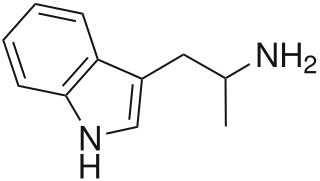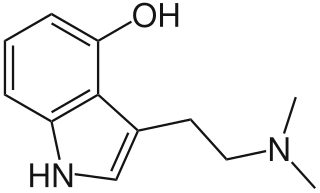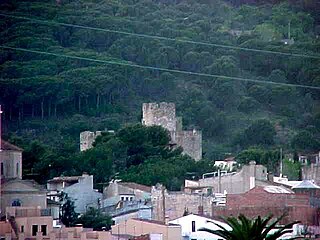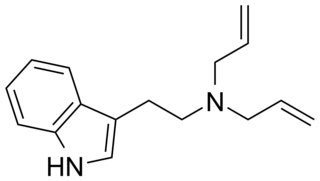
α-Methyltryptamine is a psychedelic, stimulant, and entactogen drug of the tryptamine class. It was originally developed as an antidepressant by workers at Upjohn in the 1960s, and was used briefly as an antidepressant in Russia under the trade name Indopan before being discontinued.

5-MeO-aMT or 5-methoxy-α-methyltryptamine, α,O-Dimethylserotonin (Alpha-O) is a potent psychedelic tryptamine. It is soluble in ethanol.

Psilocin is a substituted tryptamine alkaloid and a serotonergic psychedelic substance. It is present in most psychedelic mushrooms together with its phosphorylated counterpart psilocybin. Psilocin is a Schedule I drug under the Convention on Psychotropic Substances. The mind-altering effects of psilocin are highly variable and subjective and resemble those of LSD and DMT.

5-MeO-DALT or N,N-di allyl-5-methoxy tryptamine is a psychedelic tryptamine first synthesized by Alexander Shulgin.

Vilassar de Dalt is a village in Catalonia, Spain, in the province of Barcelona and the comarca of Maresme. The name comes from the Roman name Villa Azari, later changed to Vilassar. In the 20th century, it split into two villages: Vilassar in the hills, and Vilassar by the Sea.

5-MeO-DPT, is a psychedelic and entheogenic designer drug.

Vall d'Hebron is a neighborhood in the Horta-Guinardó district of Barcelona, Catalonia, Spain.

3-Methoxyphencyclidine (3-MeO-PCP) is a dissociative hallucinogen of the arylcyclohexylamine class related to phencyclidine (PCP) which has been sold online as a designer drug. It acts mainly as an NMDA receptor antagonist, though it has also been found to interact with the sigma σ1 receptor and the serotonin transporter. The drug does not possess any opioid activity nor does it act as a dopamine reuptake inhibitor.

4-Methoxyphencyclidine is a dissociative anesthetic drug that has been sold online as a research chemical. The synthesis of 4-MeO-PCP was first reported in 1965 by the Parke-Davis medicinal chemist Victor Maddox. A 1999 review published by a chemist using the pseudonym John Q. Beagle suggested the potency of 4-MeO-PCP in man was reduced relative to PCP, two years later Beagle published a detailed description of the synthesis and qualitative effects of 4-MeO-PCP, which he said possessed 70% the potency of PCP. 4-MeO-PCP was the first arylcyclohexylamine research chemical to be sold online, it was introduced in late 2008 by a company trading under the name CBAY and was followed by several related compounds such as 3-MeO-PCP and methoxetamine. 4-MeO-PCP has lower affinity for the NMDA receptor than PCP, but higher affinity than ketamine, it is orally active in a dosage range similar to ketamine, with some users requiring doses in excess of 100 mg for desired effects. Users have reported substantial differences in active dose, these discrepancies can be partially explained by the presence of unreacted PCC and other impurities in samples sold on the grey market. 4-MeO-PCP has Ki values of 404 nM for the NMDA receptor, 713 nM for the norepinephrine transporter, 844 nM for the serotonin transporter, 296 nM for the σ1 receptor and 143 nM for the σ2 receptor.

N,N-Diallyltryptamine (DALT) is a tryptamine derivative which has been identified as a new psychoactive substance. It has been used as an intermediate in the preparation of radiolabeled diethyltryptamine.

5-Ethoxy-DMT is a tryptamine derivative which has been previously synthesized as a chemical intermediate, but has not been studied to determine its pharmacology.

N-Ethylnorketamine is a designer drug which is presumed to have similar properties to ketamine, a dissociative anesthetic drug with hallucinogenic and sedative effects. It has been sold over the internet since around September 2012, and identified in seized drug samples by analytical laboratories in the UK and other European countries.

3-Methoxyeticyclidine (3-MeO-PCE), also known as methoxieticyclidine, is a dissociative anesthetic that is qualitatively similar to PCE and PCP and has been sold online as a designer drug.

3-Hydroxyphencyclidine (3-HO-PCP) is a dissociative of the arylcyclohexylamine class related to phencyclidine (PCP) that has been sold online as a designer drug.

5-MeO EiPT is a psychedelic of the tryptamine class that has been sold online as a designer drug.

5-MeO-MALT (5-methoxy-N-methyl-N-allyltryptamine) is a lesser-known psychedelic drug that is closely related to 5-MeO-DALT and used to be sold online as a designer drug.

5-MeO-MET (5-Methoxy-N-methyl-N-ethyltryptamine) is a relatively rare designer drug from the substituted tryptamine family, related to compounds such as N-methyl-N-ethyltryptamine and 5-MeO-DMT. It was first synthesised in the 1960s and was studied to a limited extent, but was first identified on the illicit market in June 2012 in Sweden. It was made illegal in Norway in 2013, and is controlled under analogue provisions in numerous other jurisdictions.

MALT is a lesser-known drug from the tryptamine family. It is a novel compound with very little history of human use. It is closely related to methylpropyltryptamine (MPT), as well as N-methyltryptamine. It has been sold online as a designer drug. Very little information on the pharmacology or toxicity of MALT is available.


















